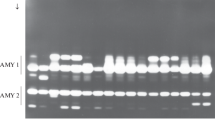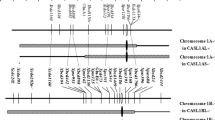Summary
Linkage studies with thirty translocations (one of the two chromosomes involved being number 4) in relation to msg24 (chromosome 4) and thirteen translocations (one of the two chromosomes involved being number 6) in relation to msg6 (chromosome 6) show without exception close linkage for all combinations tested. The results indicate that both genes are located genetically in or close to the centromere regions of their chromosomes.
Cytological analysis of two BTT stocks (balanced tertiary trisomics) ascertained the respective chromosome arms (both msg24 and msg6 on the short arms) and revealed marked differences between genetic and physical centromere distances. The reason is obviously the high content of centromeric heterochromatin occupying both the chromosome arms involved.
Similar content being viewed by others
Literature
Baker, W.K. (1958): Crossing-over in heterochromatin. Am. Nat. 92, 59–60
Becker, H.J. (1974): Mitotic recombination maps in D. melanogaster. Naturwissenschaften 61, 441–448
Burnham, C.R. (1966): Cytogenetics in plant improvement. In: Plant breeding, Symp. Iowa State University (ed. Frey, K.J.), pp. 139–187. Ames, Iowa: Iowa State University Press
Dyer, A.F. (1963): Allocyclic segments of chromosomes and the structural heterozygosity that they reveal. Chromosoma 13, 545–576
Eslick, R.F. (1971): Balanced male steriles and dominant preflowering selective genes for use in hybrid seed production. In: Barley genetics II. Proc. II Int. Barley Genetics Symp. Pullman 1969 (ed. Nilan, R.A.), pp. 292–297. Pullman (WA, USA): Washington State University Press
Falk, D.E.; Swartz, M.J.; Kasha, K.J. (1980): Linkage data with genes near the centromere of barley chromosome 6. Barley Genet. Newslett. 10, 13–16
Gropp, A.; Citoler, P.; Geisler, M. (1969): Karyotypvariation und Heterochromatinmuster bei Igeln (Erinaceus und Hemiechinus). Chromosoma 27, 288–307
Hagberg, A. (1958): Cytogenetik einiger Gerstenmutanten. Züchter 28, 32–36
Hagberg, A. (1966): Induced structural mutations in barley, especially translocation, and their use in further directed production of variation. In: Mutations in plant breeding. Proc. Panel, Vienna 1966. pp. 109–116. Vienna: IAEA
Hagberg, A. (1967): The use of induced mutations in practical barley breeding at Svalöf. In: Induzierte Mutationen und ihre Nutzung, (Hrsg. Stubbe, H.), S. 147–154. Erwin-Baur-Gedachtnisvorlesungen IV 1966, Abh. Dt. Akad. Wiss. Berlin, K1. Med., Nr. 2
Hagberg, A.; Hagberg, G. (1969): Use of induced structural rearrangements in plant breeding. In: Induced mutations in plants. Proc. Symp., Pullman 1969, pp. 647–653. Vienna: IAEA
Hanson, W.D. (1952): An interpretation of the observed amount of recombination in interchange heterozygotes of barley. Genetics 37, 90–100
Holm, G. (1960): An inversion in barley. Hereditas 46, 274–278
Hyde, B.B. (1953) Differentiated chromosomes in Plantago ovata. Am. J. Bot 40, 809–815
Kasha, K.J. (1979): Viable deficiency-duplications of the centromere regions of Zea mays chromosomes. Maydica 24, 23–31
Kramer, H.H.; Blander, B.A.S. (1961): Orienting linkage maps on the chromosomes of barley. Crop Sci. 1, 339–342
Kreft, I. (1969): Cytological studies on an inversion in barley. Hereditas 62, 14–24
Künzel, G. (1976): Indications for a necessary revision of the barley karyogramme by use of translocations. In: Barley genetics III. Proc. III Int. Barley Genetics Symp., Garching 1975 (ed. Gaul, H.), pp. 275–281. München: Thiemig
Künzel, G.; Nicoloff, H. (1979): Further results on karyotype reconstruction in barley. Biol. Zentralbl. 98, 587–592
Künzel, G.; Scholz, F. (1982): Untersuchungen zur Kopplung zwischen induzierten Translokationen und Genen für männliche Sterilitat bei Gerste. Kulturpflanze 30, 155–165
Lehmann, L.; Hagberg, P. (1978): Linkage studies of msg6 using four translocations involving chromosomes 5 and 6. Barley Genet. Newslett. 8, 73–74
Lewin, B.M. (1980): Gene expression. In: Eucaryotic chromosomes. Vol. 2, p. 1160. New York: Wiley and Sons
Linde-Laursen, I. (1975): Giemsa C-banding of the chromosomes of ‘Emir’ barley. Hereditas 81, 285–289
Linde-Laursen, I. (1978): Giemsa C-banding of barley chromosomes. II. Banding patterns of trisomics and telotrisomics. Hereditas 89, 37–41
Linde-Laursen, I.; Doll, H.; Nielsen, G. (1982): Giemsa C-banding patterns and some biochemical markers in a pedigree of European barley. Z. Pflanzenzucht. 88, 191–219
Linnert, G. (1955): Die Struktur der Pachytanchromosomen in Euchromatin und Heterochromatin und ihre Auswirkung auf die Chiasmabildung bei Salvia-Arten. Chromosoma 7, 90–128
Natarajan, A.T.; Gropp, A. (1971): The meiotic behaviour of autosomal heterochromatic segments in hedgehogs. Chromosoma 35, 143–152
Noda, K.; Kasha, K.J. (1978): A proposed karyotype revision based on C-band chromosome identification. Crop Sci. 18, 925–930
Nilan, R.A.; Powell, J.B.; Conger, B.V.; Muir, C.E. (1968): Induction and utilization of inversions and mutations in barley. In: Mutations in plant breeding II. Proc. Panel, Vienna 1967, pp. 193–203. Vienna: IAEA
Persson, G. (1969a): An attempt to find suitable genetic markers for dense ear loci in barley I. Hereditas 62, 25–96
Persson, G. (1969b): An attempt to find suitable genetic markers for dense ear loci in barley II. Hereditas 63, 1–28
Persson, G. (1969c): Genetic analysis of a quantitative character, ear internode length, in barley. University of Lund, p. 26. Lund: Berlingska Boktryckeriet
Ramage, R.T. (1964): Chromosome aberrations and their use in genetics and breeding — translocations. In: Barley genetics I. Proc. I Int. Barley Genetics Symp. pp. 99–115. Wageningen: Pudoc 1963
Ramage, R.T. (1965): Balanced tertiary trisomics for use in hybrid seed production. Crop Sci. 5, 177–178
Singh, R.J.; Tsuchiya, T. (1981): Identification and designation of barley chromosomes by Giemsa banding technique: a reconsideration. Z. Pflanzenzucht. 86, 336–340
Snoad, B. (1963): Tomato chromosomes and their relationship to the linkage maps. In: Genetics today. Vol.1, p. 117. Proc. 11. Intern. Congr. Genet. Oxford: Pergamon Press
Tjio, J.H.; Hagberg, A. (1951): Cytological studies on some X-ray mutants of barley. An. Estac. Exp. Aula Dei 2, 149–167
Tsuchiya, T. (1981): Current linkage maps of barley. Barley Genet. Newslett. 11, 96–98
Tuleen, N.A. (1973): Karyotype analysis of multiple translocation stocks of barley. Can. J. Genet. Cytol. 15, 267–273
Zenzes, M.T.; Wolf, U. (1971): Paarungsverhalten der Geschlechtschromosomen in der mannlichen Meiose von Microtus agrestis. Chromosoma 33, 41–47
Author information
Authors and Affiliations
Additional information
Communicated by F. Mechelke
Rights and permissions
About this article
Cite this article
Künzel, G. Differences between genetic and physical centromere distances in the case of two genes for male sterility in barley. Theoret. Appl. Genetics 64, 25–29 (1982). https://doi.org/10.1007/BF00303645
Received:
Issue Date:
DOI: https://doi.org/10.1007/BF00303645




